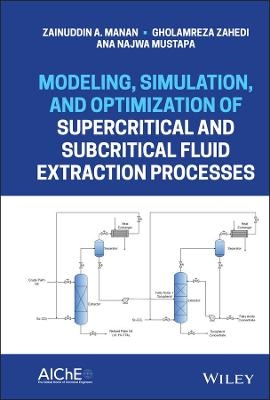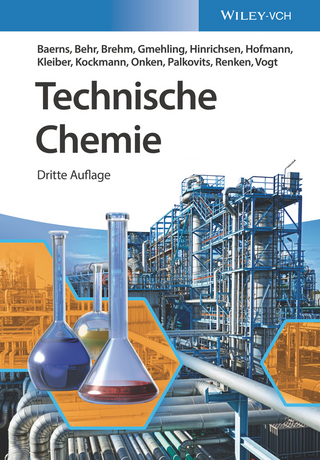
Modeling, Simulation, and Optimization of Supercritical and Subcritical Fluid Extraction Processes
Wiley-AIChE (Verlag)
978-1-118-46017-7 (ISBN)
Zainuddin A. Manan is Professor of Chemical Engineering, founding Director of Process Systems Engineering Centre, and founding Dean of Faculty of Chemical and Energy Engineering at Universiti Teknologi Malaysia. Gholamreza Zahedi is former Associate Professor at the Faculty of Chemical and Energy Engineering at the Universiti Teknologi Malaysia. He is Associate Editor of the Research Journal of Applied Sciences, Engineering, and Technology. He is currently working at Leprino Foods. Ana Najwa Mustapa is Senior Lecturer at the School of Chemical Engineering, College of Engineering at Universiti Teknologi Mara (UiTM).
Preface xiii
Nomenclature xvii
1 Fundamentals of Supercritical and Subcritical Fluid Extraction 1
1.1 Introduction 1
1.2 Supercritical Fluid Properties 2
1.3 Subcritical Condition 3
1.4 Physical Properties of Subcritical Fluid 5
1.5 Principles of Sub- and Supercritical Extraction Process 7
1.5.1 Solid Sample Extraction 8
1.5.2 Liquid Sample Extraction 9
1.6 Applications of SCF Extraction 11
1.6.1 Decaffeination of Coffee and Tea 11
1.6.2 Removal of FFA in Fats and Oils 15
1.6.3 Enrichment of Tocopherols 17
1.6.4 Carotenes from Crude Palm Oil and from Palm Fatty Acid Esters 18
1.7 Solubility of Solutes in SCFs 18
1.8 Solute–Solvent Compatibility 20
1.9 Solubility and Selectivity of Low-Volatility Organic Compounds in SCFs 21
1.10 Method of Solubility Measurement 24
1.10.1 Static Method 24
1.10.2 Dynamic Method 25
1.11 Determination of Solvent 27
1.11.1 Carbon Dioxide (CO2) 30
1.11.2 1,1,1,2-Tetrafluoroethane (R134a) as a Solvent 31
1.12 Important Parameters Affecting Supercritical Extraction Process 36
1.12.1 Pressure and Temperature 36
1.12.2 Solvent Flowrate 38
1.12.3 Cosolvent 39
1.12.4 Moisture Content 40
1.12.5 Raw Material 42
1.13 Profile of Extraction Curves 43
1.14 Design and Scale Up 45
2 Modeling and Optimization Concept 47
2.1 SFE Modeling 47
2.1.1 Importance of Knowing the Solid Matrix and Selecting a Suitable Model 48
2.1.2 Different Modeling Approaches in SFE 48
2.1.2.1 Experimental Models 49
2.1.2.2 Models Which Are Based on Similarity between Heat and Mass Transfer 49
2.1.2.3 Models Based on Conservation Balance Equations 49
2.2 First Principle Modeling 49
2.2.1 The Equation of Continuity 50
2.2.2 The Equation of Motion in Terms of τ 50
2.2.3 The Equation of Energy in Terms of q 52
2.3 Hybrid Modeling or Gray Box 53
2.4 ANN 55
2.4.1 Simple Neural Network Structure 55
2.4.1.1 Transfer Function 57
2.4.1.2 Activation Functions 57
2.4.1.3 Learning Rules 57
2.4.2 Network Architecture 58
2.5 Fuzzy Logic 61
2.5.1 Boolean Logic and Fuzzy Logic 61
2.5.2 Fuzzy Sets 62
2.5.3 Membership Function 63
2.5.3.1 Membership Function Types 63
2.5.4 Fuzzy Rules 64
2.5.4.1 Classical Rules and Fuzzy Rules 65
2.5.5 Fuzzy Expert System and Fuzzy Inference 66
2.5.5.1 Mamdani FIS 66
2.5.5.1.1 Fuzzification 66
2.5.5.1.2 Fuzzy Logical Operation and Rule Evaluation 66
2.5.5.1.3 Implication Method 67
2.5.5.1.4 Aggregation of the Rule Outputs 67
2.5.5.1.5 Defuzzification 67
2.5.5.2 Sugeno Fuzzy Inference 67
2.6 Neuro Fuzzy 68
2.6.1 Structure of a Neuro Fuzzy System 69
2.6.2 Adaptive Neuro Fuzzy Inference System (ANFIS) 69
2.6.2.1 Learning in the ANFIS Model 71
2.7 Optimization 72
2.7.1 Traditional Optimization Methods 73
2.7.2 Evolutionary Algorithm 74
2.7.3 Simulated Annealing Algorithm 74
2.7.4 Genetic Algorithm 75
2.7.4.1 Genetic Algorithm Definitions 75
2.7.4.2 Genetic Algorithms Overview 76
2.7.4.3 Preliminary Considerations 77
2.7.4.4 Overview of Genetic Programming 78
2.7.4.5 Implementation Details 79
2.7.4.5.1 Selection Operator 79
2.7.4.5.2 Crossover Operator 79
2.7.4.5.3 Mutation Operator 79
2.7.4.6 Effects of Genetic Operators 80
2.7.4.7 The Algorithms 80
3 Physical Properties of Palm Oil as Solute 83
3.1 Introduction 83
3.2 Palm Oil Fruit 83
3.3 Palm Oil Physical and Chemical Properties 84
3.3.1 Palm Oil Triglycerides 85
3.3.2 Minor Components in Palm Oil 89
3.4 Vegetable Oil Refining 91
3.5 Conventional Palm Oil Refining Process 91
3.5.1 Chemical Refining 93
3.5.2 Physical Refining 97
3.5.3 Effect of Palm Oil Refining 98
3.6 Conclusions 100
4 First Principle Supercritical and Subcritical Fluid Extraction Modeling 101
Part I: Modeling Methodology 101
4.1 Introduction 101
4.2 Phase Equilibrium Modeling 101
4.3 The Redlich–Kwong–Aspen Equation of State 102
4.3.1 Calculations of Pure Component Parameters for the RKA-EOS 102
4.3.2 Binary Mixture Calculations 103
4.4 Palm Oil System Characterization 103
4.4.1 Palm Oil Triglycerides 104
4.4.2 Free Fatty Acids 106
4.4.3 Palm Oil Minor Components 106
4.5 Development of Aspen Plus® Physical Property Database for Palm Oil Components 107
4.5.1 Vapor Pressure Estimation 107
4.5.2 Estimation of Pure Component Critical Properties 108
4.5.2.1 Critical Properties Estimation Using Normal Boiling Point 108
4.5.2.2 Critical Properties Estimation Using One Vapor Pressure Point 110
4.6 Binary Interaction Parameters Calculations 110
4.7 Supercritical Fluid Extraction Process Development 113
4.7.1 Hydrodynamics of Countercurrent SFE Process 113
4.7.2 Solubility of Palm Oil in Supercritical CO2 115
4.7.3 Process Modeling and Simulation 116
4.7.3.1 Simple Countercurrent Extraction 118
4.7.3.2 Countercurrent Extraction with External Reflux 118
4.7.4 Process Analysis and Optimization 119
Part II: Results and Discussion 120
4.8 Palm Oil Component Physical Properties 120
4.8.1 Vapor Pressure of Palm Oil Components 120
4.8.2 Pure Component Critical Properties 122
4.9 Regression of Interaction Parameters for the Palm Oil Components-Supercritical CO2 Binary System 122
4.9.1 Binary System: Triglyceride – Supercritical CO2 123
4.9.2 Binary System: Oleic Acid – Supercritical CO2 126
4.9.3 Binary System: α-Tocopherol – Supercritical CO2 128
4.9.4 Binary System: β-Carotene – Supercritical CO2 130
4.9.5 Temperature-Dependent Interaction Parameters 131
4.10 Phase Equilibrium Calculation for the Palm Oil–Supercritical CO2 System 132
4.11 Ternary System: CO2 – Triglycerides – Free Fatty Acids 133
4.12 Distribution Coefficients of Palm Oil Components 134
4.13 Separation Factor Between Palm Oil Components 138
4.13.1 Separation Factor Between Fatty Acids and Triglycerides 139
4.13.2 Separation Factor Between Fatty Acids and α-Tocopherols 140
4.14 Base Case Process Simulation 141
4.14.1 Palm Oil Deacidification Process 141
4.14.1.1 Solubility of Palm Oil in Supercritical CO2 141
4.14.1.2 Palm Oil Deacidification Process: Comparison to Pilot Plant Results 142
4.15 Conclusion 145
5 Application of Other Supercritical and Subcritical Modeling Techniques 147
5.1 Mass Transfer, Correlation, ANN, and Neuro Fuzzy Modeling of Sub-and Supercritical Fluid Extraction Processes 147
5.2 Mass Transfer Model 148
5.3 ANN Modeling 153
5.4 Neuro Fuzzy Modeling 153
5.5 ANFIS and Gray-box Modeling of Anise Seeds 154
5.6 White Box SFE Modeling of Anise 155
5.6.1 Gray Box Parameters 156
5.6.2 ANFIS 156
5.6.2.1 Preprocessing 157
5.6.3 Gray Box 158
5.7 Results and Discussion 159
5.7.1 ANFIS 159
5.7.2 Gray Box Modeling Results 159
5.7.2.1 Black Box 159
5.7.3 Comparison of ANFIS and Gray Box Models with ANN and White Box Models 161
5.8 Introduction – Statistical versus ANN Modeling 162
5.9 Supercritical Carbon Dioxide Extraction of Q. infectoria Oil 164
5.9.1 Materials and Methods 165
5.9.2 Experimental Design 165
5.9.3 Artificial Neural Network Modeling 168
5.10 Subcritical Ethanol Extraction of Java Tea Oil 168
5.10.1 Artificial Neural Network Modeling 172
5.11 SFE of Oil from Passion Fruit Seed 173
5.11.1 Experimental Procedures 173
5.11.2 RSM Statistical Modeling 174
5.11.3 ANN Modeling of Passion Fruit Seed Oil Extraction with Supercritical Carbon Dioxide 176
6 Experimental Design Concept and Notes on Sample Preparation and SFE Experiments 179
6.1 Introduction 179
6.2 Experimental Design 179
6.3 Statistical Optimization 180
6.4 Optimization of Palm Oil Subcritical R134a Extraction 182
6.4.1 Effect of Temperature and Pressure 184
6.4.2 Model Fitting 187
6.4.3 Process Optimization 189
6.5 Comparison of Subcritical R134a and Supercritical CO2 Extraction of Palm Oil 190
6.5.1 Extraction Performance 191
6.5.2 Economic Factor 196
6.6 Sample Pretreatment 197
6.6.1 Moisture Content Reduction 198
6.6.2 Sample Size Reduction 199
6.7 New Trends in Pretreatment 200
6.8 Optimal Pretreatment 203
7 Supercritical and Subcritical Optimization 205
Part I: First Principle Optimization 205
7.1 Introduction 205
7.2 Evaluation of Separation Performance 205
7.2.1 Effects of Temperature and Pressure 206
7.2.2 Effect of the Number of Stages 207
7.2.3 Effect of Solvent-to-Feed Ratio 208
7.2.4 Effect of Reflux Ratio 209
7.3 Parameter Optimization of Palm Oil Deacidification Process 210
7.3.1 Simple Countercurrent Extraction (Without Reflux) 212
7.3.2 Countercurrent Extraction with Reflux 213
7.4 Proposed Flowsheet for Palm Oil Refining Process 215
7.5 Conclusions 216
Part II: ANN, GA Statistical Optimization 217
7.6 Introduction 217
7.7 Traditional Optimization 217
7.8 Nimbin Extraction Process Optimization 220
7.9 Genetic Algorithm for Mass Transfer Correlation Development 223
7.10 Optimizing Chamomile Extraction 225
7.11 Statistical and ANN Optimization 227
7.12 Conclusion 232
Appendix A Calculation of the Composition for Palm Oil TG (Lim et al. 2003) 233
Appendix B Calculation of Distribution Coefficient and Separation Factor (Lim et al. 2003) 235
Appendix C Calculation of Palm Oil Solubility in Supercritical CO2 (Lim et al. 2003) 237
References 239
Index 265
| Erscheint lt. Verlag | 28.12.2021 |
|---|---|
| Sprache | englisch |
| Maße | 158 x 231 mm |
| Gewicht | 567 g |
| Themenwelt | Naturwissenschaften ► Chemie ► Technische Chemie |
| Technik ► Nachrichtentechnik | |
| Technik ► Umwelttechnik / Biotechnologie | |
| ISBN-10 | 1-118-46017-0 / 1118460170 |
| ISBN-13 | 978-1-118-46017-7 / 9781118460177 |
| Zustand | Neuware |
| Informationen gemäß Produktsicherheitsverordnung (GPSR) | |
| Haben Sie eine Frage zum Produkt? |
aus dem Bereich


